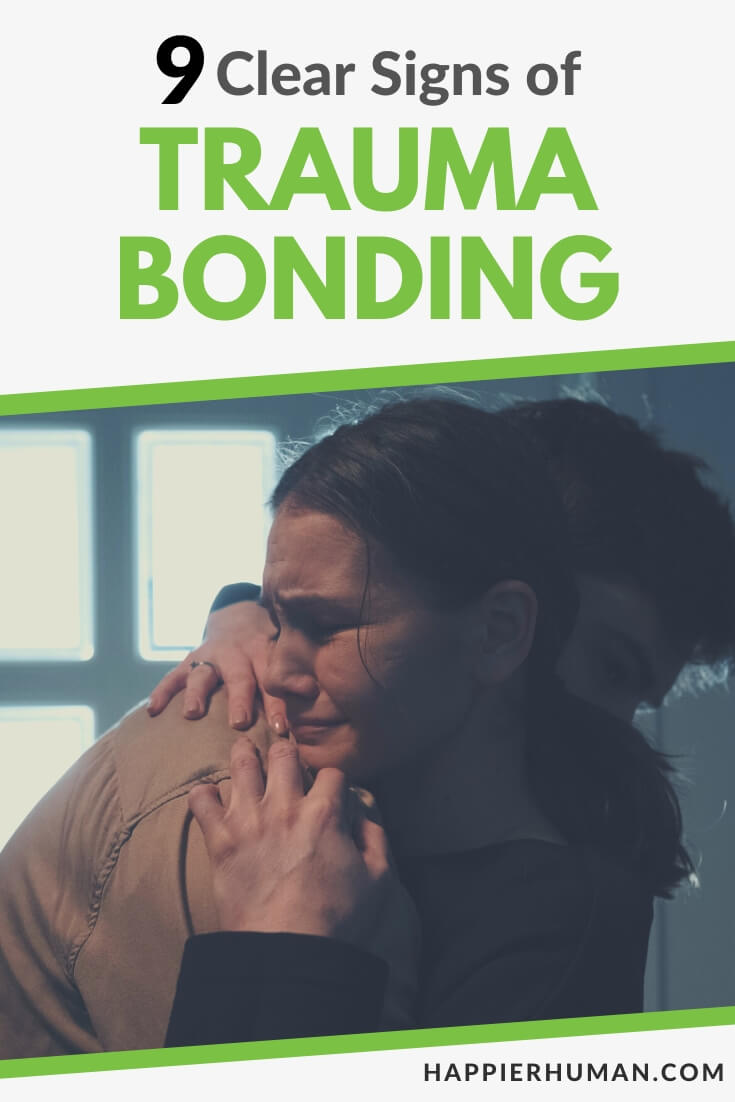When you hear about the trauma and abuse some people face in relationships, you might wonder, ‘How did it get to that point.’
Even those who’ve been through traumatic relationships can find it difficult to understand why they didn’t leave when they saw the first red flag.
Truth be told, trauma is a complex phenomenon.
Even in the worst situations, we find ways to cope with pain and adapt to discomfort.
It’s what the human mind does.
When it comes to abusive relationships, where bad things happen gradually and cyclically, trauma bonding keeps the victim from leaving.
It is the endless cycle of love bombing followed by criticism, followed by promises of change, and so on, that keeps the victim in a state of confusion and self-doubt.
Let’s take a closer look at what trauma bonding is and why it’s so complicated to escape this toxic relationship dynamic.
What is Trauma Bonding?
Before Patrick Barnes coined the term “trauma bonding,” psychologists would use Stockholm syndrome to describe a dynamic in which victims develop bonds with their abusers.
In many cases, these bonds are so strong that victims end up defending the perpetrators.
As many experts agree, the victim-perpetrator dynamic is often shrouded in silence and shame, making it difficult for victims to escape and for outsiders (friends, family members, or coworkers) to see what’s happening in the relationship. [1]
As Patrick Barnes describes it, trauma bonding is a “dysfunctional attachment that occurs in the presence of danger, shame, or exploitation.”
On the one hand, we have the need for attachment, a need that every human has and relies on for survival.
Since abusive interactions threaten their physical and psychological integrity, victims will eventually develop attachments towards their aggressors as a survival mechanism.
On the other hand, abuse happens in cycles.
That means an abuser will gain their victim’s trust, inflict physical or psychological harm, then apologize and promise not to repeat it.
When you combine these two elements, you get a complex dynamic from which even the most resilient individuals find it difficult to escape.
Why Don’t They Leave?
To understand why breaking trauma bonds is so complex, we must look at how abusers typically operate.
Most abusive relationships have idyllic beginnings, a wonderful love story that makes you think, “Wow… he/she is exactly what I need.”
The Idealization Phase
It all starts with them showering you with attention, gifts, compliments, and grand displays of affection. This is called love bombing.
On top of that, their apparent openness and transparency make you trust them almost instantly.
All these warm and fuzzy feelings you experience because of their overwhelming affection and apparent trustworthiness are the foundation of the attachment bond.

It’s important to note that gaining trust (instantly) and love bombing are part of an entire arsenal of manipulation tactics that narcissists typically use in the early stages of the relationship. [2]
At some point, this idyllic phase begins to fade, and the abuser shows his true colors.
The Devaluation Phase
Through criticism, they seek to chip away at your self-esteem until you start blaming yourself for all the drama and emotional turmoil you experience.
But let’s say you’re not that easily manipulated. You have a healthy sense of self-respect, so you don’t assume it’s your fault just because your partner says so.
So, you defend yourself by fighting back and calling out their abuse.
At that point, they will most likely pull out another ‘classic’ manipulation tactic called ‘gaslighting.’
In other words, they will accuse you of blowing things out of proportion or causing drama when all you really did was react to their mistreatment.
Depending on the intensity of your reaction, the abuser will back off and apologize, but not because he’s sorry. It’s just another manipulation tactic to keep you in the relationship.
And It Keeps Getting Worse…
Just because they’re sorry doesn’t mean it’s over.
The cycle continues, leaving your self-esteem in shambles which automatically helps him gain more control over the relationship dynamic.
After repeated incidents, you end up resigning and accepting his
When victims realize the severity of the situation, they often experience overwhelming feelings of powerlessness, guilt, and shame.
Recovery is slow and challenging as victims experience trauma symptoms and self-esteem issues, even after six months. [3]
Who is Susceptible to Trauma Bonding?
Although some of us are more susceptible to trauma bonding than others, it’s vital to remember that everyone – regardless of family history or emotional resilience – can fall into this toxic dynamic.
Trauma bonding occurs when the victim becomes attached to someone toxic and destructive to them.
Adult survivors of abusive and dysfunctional relationships
Whether it’s maltreatment in the form of emotional, physical, or sexual abuse or exposure to abusive relationships (e.g., a child witnessing one parent exerting abuse on the other), most victims of trauma bonding have a complicated past.
Unfortunately, children who experience early adverse and traumatic experiences or major emotional neglect can become adults with attachment issues. [4]
These children often become adults who choose to stay in abusive relationships despite feeling unhappy and miserable.
Why? Because it’s almost impossible for them to imagine anything else but the unhealthy attachment styles they’re used to from early childhood.
People who are lonely or lack social support
Whether it’s because you’ve just moved to a new city/country or simply lost touch with your friends and family members for whatever reasons, the lack of close relationships can make you more susceptible to abusive relationships.
Abusers are typically charismatic figures who can quickly gain your trust and make you fall in love with them almost instantly.
Having a close friend means someone can see your relationship differently and point out red flags you ignore or don’t see.
9 Signs You Might Be Dealing with Trauma Bonding:
1. Things Get Too Serious Too Quickly
We all know that instant attraction is a red flag.
Whenever you fall hard for someone, it’s wise to take a step back and approach the interaction patiently and maturely.
But most of the time, we can’t help it.
It’s even harder to resist when the other person seems so determined to invest in something serious.
Or when they paint this idyllic version of an almost impossible relationship.
Long story short, if things tend to get serious too quickly, something fishy is going on.
2. You’ve Lost Touch with Your Close Ones
Every trauma-bonded relationship begins with an almost irresistible feeling of attraction.
It’s so intoxicating that you want to spend every hour of every day with your significant other.
As time passes, you lose touch with your loved ones, friends, or family.
Maybe you were just taken away by all the exciting things happening in your life, or maybe you drifted away because they didn’t like your new sweetie (I wonder why).

Plus, your partner doesn’t seem thrilled about them either and tends to get frustrated when you spend time with others.
But who cares. You’re in this awesome relationship that fulfills all your needs and aspirations.
And because it feels so “right,” you sacrifice your social life to prioritize the relationship.
This huge red flag indicates you may have gotten trauma-bonded with a narcissistic abuser.
2. You Compromise Yourself for the Sake of the Relationship
This is one of the most subtle signs of trauma bonding.
When you’re mainly focused on the relationship and rarely on your needs, the power dynamic slowly shifts in their favor.
On top of that, abusers typically use gaslighting to make you think that you’re the one who’s crazy, overly sensitive, too demanding, and so on.
Months or years of gaslighting will get you to a point where you feel indebted and don’t even realize how much you’ve sacrificed for the sake of the relationship.
3. You Try to Set Boundaries, but They Keep Crossing Them
I believe that keeping boundaries is just as important as setting them.
Some people respect you enough to understand and honor your boundaries.
Unfortunately, others see you as a means to satisfy their needs, so they constantly test and cross your boundaries.
But don’t feel ashamed for having a hard time keeping your boundaries. We all struggle with that to a certain degree.
Just remember that when your significant other shows little to no respect for your boundaries but you still choose to be with them, this could indicate trauma bonding.
4. You’re Afraid to Speak Out Every Time They Mistreat You
Remember the Devaluation Phase I told you about earlier?
The one in which the abuser chips away at your self-esteem through criticism and gaslighting.
When self-doubt takes root in your mind, and every attempt to discuss what’s bothering you ends up with them threatening to leave, fear takes over.
In my opinion, being in a relationship where you’re afraid to address disrespectful attitudes or mistreatment is never a good sign.
It’s not healthy or mature love that keeps you there, but a traumatic bond.
5. You Blame Yourself for Everything
When working with victims of trauma bonding, one of the first aspects I address is the uncomfortable mix of guilt and shame they experience shortly after ending the relationship.
In fact, guilt and shame are often the ‘glue’ that keeps the trauma bond.
Despite feeling that you don’t matter, you somehow find a way to blame yourself, not just for your unhappiness, but for their aggressive and invalidating reactions as well.
As a rule of thumb, when two people disagree (especially in romantic relationships), both contribute to how things unfold.
That’s why blaming yourself for everything while your partner takes zero responsibility is a sign of trauma bonding.
6. You Feel Lost Without Them
A mature relationship comprises two people who choose to be together not because they need each other but because they like each other.
People in trauma-bonded relationships are aware of the emotional suffering they constantly face.
They may even recognize some of their partner’s behaviors as abusive.
However, the mere thought of not being in the relationship is enough to put a knot in their stomach.
This overwhelming anxiety they experience at the thought of ‘losing’ the relationship stems from abandonment issues.
When the loss feels more substantial than the love, you may be dealing with trauma bonding.
7. You Make Up Excuses for Their Maltreatment
One of the strongest indicators of abuse and trauma bonding is the victim’s attitude toward their aggressor.
In other words, victims often tend to cover up the abuse by making excuses for their partner’s inappropriate or hurtful attitudes.
Some examples may sound like this:
On the one hand, you make up excuses because you’re ashamed of what others might think.
On the other hand, you repeat these excuses in your head because you need to justify your decision to stay, despite the constant emotional pain that tells you you’re not in a good place.
8. You Compromise Yourself for the Sake of the Relationship
This is one of the most subtle signs of trauma bonding.
When you’re mainly focused on the relationship and rarely on your needs, the power dynamic slowly shifts in their favor.

On top of that, abusers typically use gaslighting to make you think that you’re the one who’s crazy, overly sensitive, too demanding, and so on.
Months or years of gaslighting will get you to a point where you feel indebted and don’t even realize how much you’ve sacrificed for the sake of the relationship.
9. You Feel as If You’re Running in Circles
Abuse typically unfolds in cycles.
One day they tell you that you’re the most amazing person he’s ever met; the next day, they make you feel like you’re not good enough.
Every time you get upset (as any normal person would) because they mistreated or disrespected you, they immediately resort to gaslighting to make you feel like you’re the problem.
When you fall for this trap, they portray themselves as the patient and understanding partner who will help you work through your issues.
When they can’t use gaslighting or blame-shifting, they feed you a “crocodile tears” apology, followed by a promise of change that does not happen.
If you’ve witnessed this cycle a couple of times and continue to tell yourself, “This time will be different,” you will only prolong your suffering and set yourself up for another painful disappointment.
Final Thoughts on Trauma Bonding
Trauma bonding is a phenomenon that can occur in various types of interpersonal dynamics, from romantic relationships to hostage situations, human trafficking, and cults. [5]
It is a bond characterized by a power imbalance that favors the aggressor, who uses positive and negative interactions to keep you confused and powerless. [6]
Given the complexity of this phenomenon, it’s no wonder victims find it difficult to spot the abuse and let go of the relationship.
Not only that recognizing the signs of trauma bonding helps you avoid this toxic relationship dynamic, but it’s also the first step in dealing (and healing) with it.
Stay safe.
And if you're looking for more articles about relationships, be sure to check out these blog posts:
- 5 Reasons to Stop Chasing People and Relationships
- 11 Reasons Empaths Form Relationships with Narcissists
- How to Fix an Anxious Attachment Style in Your Relationships

Alexander Draghici is a licensed Clinical Psychologist, CBT practitioner, and content writer for various mental health websites. His work focuses mainly on strategies designed to help people manage and prevent two of the most common emotional problems – anxiety and depression.
References
| [1] | W. Middleton, A. Sachs and M. J. Dorahy, “The abused and the abuser: Victim–perpetrator dynamics,” Journal of Trauma & Dissociation, vol. 18, no. 3, 2017. |
| [2] | C. C. Strutzenberg, J. D. Wiersma-Mosley, K. N. Jozkowski and J. N. Becnel, “Love-bombing: A Nar e-bombing: A Narcissistic Appr cissistic Approach to Relationship F o Relationship Formation ormation,” Discovery, The Student Journal of Dale Bumpers College of Agricultural, Food and Life Sciences, vol. 18, no. 1, pp. 81-89, 2017. |
| [3] | D. G. Dutton and S. Painter, “Emotional attachments in abusive relationships: A test of traumatic bonding theory.,” Violence and Victims, vol. 8, no. 2, p. 105–120, 1993. |
| [4] | T. Lahousen, H. F. Unterrainer and H.-P. Kapfhammer, “Psychobiology of Attachment and Trauma—Some General Remarks From a Clinical Perspective,” Frontiers in Psychiarty, vol. 10, 2019. |
| [5] | J. A. Reid, R. A. Haskell, C. Dillahunt-Aspillaga and J. A. Thor, “CONTEMPORARY REVIEW OF EMPIRICAL AND CLINICAL STUDIES OF TRAUMA BONDING IN VIOLENT OR EXPLOITATIVE RELATIONSHIPS,” International Journal of Psychology Research, vol. 8, no. 1, 2013. |
| [6] | K. Casassa, L. Knight and C. Mengo, “Trauma Bonding Perspectives From Service Providers and Survivors of Sex Trafficking: A Scoping Review,” Trauma, Violence, & Abuse, vol. 23, no. 3, 2021. |


